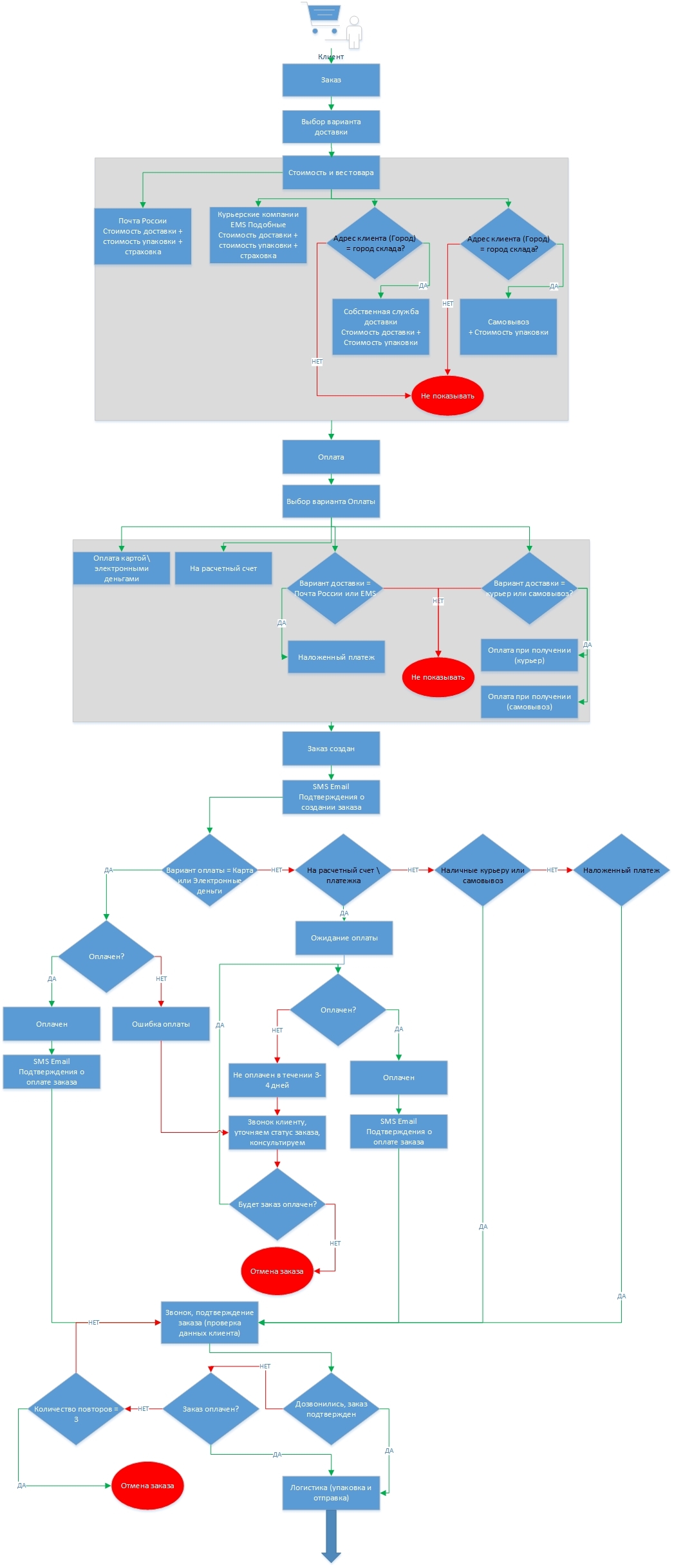Online store from scratch. Part 3: Business model and some rules
We continue our series of articles.

')
In the beginning I would like to recommend materials on the topic:
11 steps to a good online store megamozg.ru/post/24944
An interesting series, although I do not agree with all the theses
Someone too much or how the kaizen method influenced my work megamozg.ru/company/smartprogress/blog/25711
The article certainly advertises a resource, but as an introduction to kaizen will do.
A deeper study of the technique, I recommend the book:
Ron Rubin, Stuart Avery Goles - Business in the style of Zen
Liker Jeffrey - Toyota Tao
One of our goals is costing, and budget layout, a series of articles on budgeting on my blog.
To understand the basics of marketing:
Positioning the battle for minds - Jack Trout and Al Rice
So, we continue:
Detail further ...

The scheme begins with the fact that the client put the goods in the basket and proceeded to checkout.
I dropped the registration, filling in the shipping address, as well as the source from which the client came.
I didn’t even write some marketing chips at the stage of adding and selecting a product, I don’t want to overload our demo scheme.
Though we will linger a little and we will write some rules.
1. Add related products.
If a customer buys, say, an audio player, do not forget to offer him a headset, a case, a memory card, etc.
2. Similar products.
At this point, we play for promotion. If the player chosen by the client is worth 5tr. We need to offer him a more expensive option with more features.
This is the minimum of what needs to be done at this stage.
We read the scheme:
Order: the product is added to the cart and the customer proceeded to checkout. The first stage is the choice of a delivery method, and each of the options already has a price and an approximate delivery time is calculated.
Shipping cost is calculated based on the weight of the goods and its dimensions according to the tariffs of transport companies. In the case of third-party transport workers insurance is added.
Also in the cost of delivery includes the cost of packaging, which in turn consists of the cost of packaging materials and the time that an employee spends on packaging. Additionally, there may be the cost of shipping the order to the point of delivery of the transport company.
The cost of packaging can be calculated in two ways:
1. The approximate cost or "average temperature in the hospital."
Calculates the average cost for a certain period of the store. For example, we calculated that the packaging of one order takes from 5 to 15 minutes of working time and from 20p to 40p the cost of packaging materials.
Consider the average:
Time 10 minutes
The cost of packaging materials 30r.
With a large number of similar orders this option is suitable.
Usually done with a margin upwards. On the one hand, well, you do not need to bother and in standard orders the price of delivery is more or less adequate, but at non-standard it is too high, which may scare the customer. Or you can go to minus on the actual shipping cost.
2. Exact calculation.
Difficult calculation option, which gives us the most accurate shipping cost. It is calculated according to the formula, where the weight is taken into account, and the dimensions of all components of the order are on the sides (that is, we can calculate how much packaging material we need and what kind of packaging we need).
The first option does not require major software improvements and is usually handled by the system for calculating the cost of delivery, some of these services were listed in the first part. There, simply to the cost that the system calculates, the tariff, we add our average values and give this option to the client.
But for a serious project, where the issue of cost is acute, you need to do the second option, with a large number of different orders, it is difficult to get into the narrow gate. Where, on the one hand, not to overcharge the cost of delivery, and, on the other hand, do not go into a minus.
So, the customer chooses the delivery option. According to the scheme, we see that if the client’s address, namely his city, coincides with the city where the store has a warehouse, we show two more delivery options: courier and pickup. If the city does not match, then these options are not available.
Next, the client chooses the payment option. There is also a logic module.
If the delivery option is selected by Russian Post or EMS (or other transport workers providing the “pay on delivery” service), we offer the “Cash on delivery” option.
It looks like this:
If you choose Russian Post or EMS, then suggest \ display the payment option Cash on delivery.
For a programmer, this line is clearer than half a page of sheets explaining what we want to receive. This is one of the rules for writing TK for development groups, an algorithm and a clear, logical description.
One more: If “Courier” or “Pickup” is selected, then suggest \ display the payment option “Payment upon receipt”
Then our client chooses the payment option and places the order. When creating an order, we send it a notification via SMS and Email. After that we have a division depending on the selected payment options.
If one of the options of instant payment is selected, a card or electronic money, and if the order is paid, the status is set to “Paid” and a notification is sent to the customer via SMS and Email about receipt of payment by the store. If the order is not paid, and with the instant payment option, this is a system or customer error in the payment process, the operator should contact the customer and clarify the cause of the error and offer the customer to re-pay the order with this or other payment option. Often the client makes a mistake when entering some card data or on the card there is simply no money. But sometimes a system error happens, and such monitoring provides an opportunity not only to return the client and bring the transaction to payment, but also to track errors in a timely manner.
A similar algorithm when choosing the option "On the current account" or "Payment", this option is not instantaneous and takes from one to three days, the receipt of money on the current account. In this embodiment, we turn on the timer. If the order has not been paid within three days, the operator will contact the customer and clarify whether the order will be paid, and advises on payment. If the client refuses the order, find out the reason and close the order.
The remaining options with post payment, according to them the operator specifies the data on the order and transfers it to further packaging. If the order is not paid, namely the post payment and the operator three times could not get through to the recipient, the order is canceled. If the order is paid and the operator could not get through the order nevertheless is sent.
In the first case, this is justified by the fact that the courier cannot go to nowhere, or in the case of sending by cash on delivery, you should not send “Grandpa to the village” where the goods lain a month and come back with losses on the delivery ring. In the second case, the order is paid one way or another, and despite the fact that it was not possible to clarify and verify the data, and customers often make mistakes, the order must be sent.
In this analysis of the sales unit can be considered complete. Of course, the scheme is not fully detailed, we will return to it when it collects all the blocks into one scheme and consider the functions in more detail, as well as summarize and consider the points of value addition.
You can add that the operator in the process of communicating with the client, should gently and not intrusively offer additional products and accessories. From experience, I can say that a skillful “sold out” at the completion stage can offer units of goods needed by the client and increases sales.
In the next issues, we will consider the remaining stages of the order and consider many more interesting details that make up the online store.
Schemes in Visio on Yandex disk
To be continued…
Source: https://habr.com/ru/post/300592/
All Articles